The Roll the Dai 2016 Definitive Games of the Year List
“So…what are you playing these days?”
I get that a lot. I know, I know, I’m a game designer. I should have a ready list of games to recommend, but it’s hard. Every player is different and something that may blow one mind may glance off another harmlessly. Neither player is wrong. Neither player is right.
Which is all a long way of saying: game of the year lists are not meant to be objective judgments of quality. They are not meant to be arbiters of perfection. Heck, I didn’t even play some rather popular 2016 releases, including XCOM 2, Far Cry Primal, The Division, and The Last Guardian (just to name a few). This list is just the 10 games from 2016 that connected with me.
If you want some bonus commentary about games that didn’t release in 2016 or somehow otherwise were pushed off the list for some reason, stick around after the list for some Premium Content (assuming you’re a Premium Member).
All right, future heroes. Let’s do this.
10. Duskers

Duskers is a perfect example of doing one specific thing really, really well. Here, that thing is simulating being the operator of a collection of drones that are exploring derelict spaceships. The tense atmosphere is reflected in the incomplete/imperfect information that your drones send you. The vector graphics and intentionally retro UI feed into the simple functionality and commands that you can give the drones.
I played Duskers on my laptop with headphones on, and though I’ve never been a derelict-drone-operator, I can’t imagine that being one in real life feels very different. Many games aim to be immersive, but Duskers strikes true. By abstracting the control of the drones behind a fictional technology layer, it manages to narrow the gap between player and character until it is almost invisible.
There are reasons why this is down at #10, though. The random generation of rooms means that the puzzle aspect of figuring out what sequence to do things in can get monotonous. There is ostensibly a narrative and story, but the mechanics are so entirely consuming that it’s hard to care about anything else. Sometimes you forget to turn off a defense turret and send your favorite drone – who you’ve named Horatio – into the room absent-mindedly and it gets shot up and you cry for an hour.
9. The Witness

See that screenshot? That’s what The Witness wants you to believe it is – a lush world where you explore to find interesting tidbits of story and breathtaking vistas.
That is not what The Witness is. The Witness is a game about drawing lines to connect dots with an variety of completely unexplained rules about how those lines can be drawn (or what dots you’re even supposed to connect). That sounds like hogwash, right? Why make a beautiful world to walk around in if the game’s just about drawing lines in little squares?
You’re right. It shouldn’t work at all. The whole premise – not to mention the ever-more-difficult puzzles – seems designed to be infuriating. Yet, somehow, The Witness pulls it off. It manages to never change the core puzzle mechanic, yet expands your understanding of what that mechanic may include with each puzzle you solve. Its various head-scratching moments eventually translate into flashes of utter satisfaction when the light bulb finally illuminates.
It is a bit full of itself, though. There’s a story here (or at least, that’s what I’ve been told) that’s doled out in short videos and environmental hints and is utterly incomprehensible. There are times when the environment works against you, as it is unclear what is relevant to a puzzle and what isn’t. When it all comes together, it makes me feel very smart. When it doesn’t, it makes me feel supremely dumb.
8. SUPERHOT
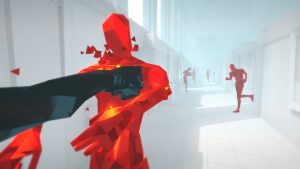
If there’s a pattern for the lower half of the 2016 top 10 list, it’s this: mechanics over narrative. If you can execute on a clever mechanic with enough style, enough innovation, and enough control, it’s often enough to make my list. Just not the top of my list.
SUPERHOT is a game mechanic that needs no narrative, which is why the narrative that frames the moments when you get to drop in and play around in the sublime sandbox of SUPERHOT so damn frustrating. It makes an effort to tell a gaming/technology meta-story, blurring the line between player and character, but falls flat.
The mechanic is simple: time moves at the speed that you do. With this very simple rule, there is the very real feeling of being superhuman. You can dodge bullets, throw swords, and steal guns with ease. All that’s needed is a library of content, a set of levels to play in, to test your ability. That’s all that SUPERHOT needs to be to me.
Unfortunately, it insists on trying to be more. I can give it a pass, though, on keeping me from playing it, because the sheer playful joy I experience when I do get the keys to the park is a real treat.
7. Rodeo Stampede
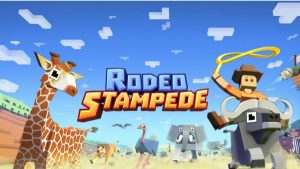
What’s this? Could it be? Yes, it’s the first mobile I’ve ever put on my various lists. Rodeo Stampede is a game where you lasso and ride various animals to tame them so you can showcase them in your airship zoo. Obviously.
I played a bunch of mobile games this year – more than normal, because there was a period of time when I was working on a mobile game. There’s a lot of good design in the mobile space, but the free-to-play space (which dominates the mobile market) is one that just has a hard time grabbing me and holding on.
Rodeo Stampede manages to do several things well. First, it takes a formula that feels familiar by now – the endless runner genre of games – and twists it just enough to make it feel unique. It smartly implements collection and upgrade mechanics as its long term meta-game. It has a variety of mid-term “quest” goals that help push the player to look and use specific animals on any given run. Lastly, there’s no energy mechanic – you can play as much as you like, though there is a cooldown on currency gain and quest acquisition.
No single piece is revolutionary, but taken as a sum, it’s a solid, well-designed package that feels fresh. The game is fun, the art is cute, and it’s an app that I’ve returned to every few days, which is more than I can say for a lot of those other little squares on my phone.
6. Trackmania Turbo

Trackmania Turbo is a nostalgia pick for me. It’s the Star Wars of games for me – it’s very hard to separate my feelings for this particular iteration of the game from the entire franchise. It’s on the list because it delivers new Trackmania content competently, and isn’t that all we really need from gaming for…ever?
There are four environments packaged in Turbo, which is better than the drip feed of single-environment releases that occurred with Trackmania 2. The drop starts, magnetic coaster track pieces, and odd double driver mode add new wrinkles to a very familiar foundation.
It’s clear that this iteration was created for consoles, though, which means that the track editor suffers power-user functionality when being used on the keyboard. Tracks are simultaneously easier to make and harder to make.
I don’t know that I’d recommend Trackmania Turbo over the other Trackmanias in a few years, but it’s a Trackmania and it came out in 2016 and it isn’t garbage. It’s hard for me to not give it a seat at the table.
5. Lego Star Wars: The Force Awakens
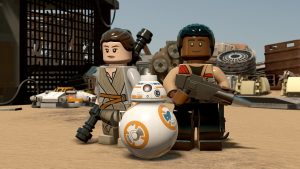
Consistency. That’s something I value in the Lego games and also something that maybe my annual list provides. This is the second year in a row in which a Lego game came in at #5. Last year, it was the dino-filled jungle romp known as Lego Jurassic World.
This year, the slot goes to Lego Star Wars: The Force Awakens (or hereafter LSW:TFA). Everything I said about previous Lego games is still true – like a familiar bowl of chicken noodle soup, the formula is strong and there’s little need to tinker with it. Some things that I especially appreciated about LSW:TFA were that it seemed to tune down the difficulty of collecting gold bricks (both through story and sandbox), that it provided new Star Wars content that didn’t appear in the movie, and that it actually managed to have decent dogfighting sequences.
It’s hard to not have fun running around with little Lego versions of your favorite Star Wars characters. There’s a lot of easygoing charm and straightforward fun to be had here.
4. Jackbox Party Pack 3
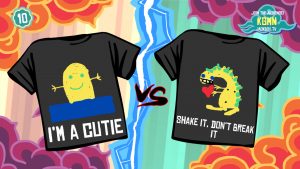
I really enjoy playing games with other people, but it’s hard. You either need to all be at separate computers at the same time or need to buy a bunch of controllers. Then, you also need each player to be roughly equally proficient at the game in most cases. Gaming with friends can be super rewarding, but it can also be frustrating (both in terms of setup and skill balance).
Somehow, into this maelstrom of problems, the Jackbox games step in and solve everything. Well, not everything. Most things. Jackbox makes games that are easy to understand and use any web-browser-using device to allow someone to play. The team has released 3 “party packs” of games, which have always been a bit hit-or-miss for me.
I was pleased to see that Party Pack 3 had mostly hits. From the classic Quiplash (with the added ability to make custom prompts) to the fairly strong social deduction/Spyfall-ish game Fakin’ It to a silly drawing game Tee K. O. where competition doesn’t muddy the waters too much, this is a great set of games for any party.
3. Rusty Lake Hotel
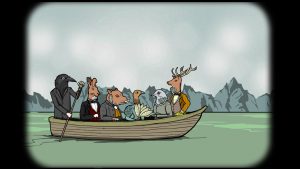
This is also a game you can play on your phone, though I played it on my computer.
It is a game where you click on things to solve puzzles and cook up tasty dinners for the animal-people who have come to stay for a week at the Rusty Lake Hotel. Its puzzles are clever – though never too difficult – and its atmosphere is sinister and creepy – though never outright scary.
It’s a short game for a small price, but it delivers about an hour of pure pleasure for those of us that remember the days when we’d play countless Room Escape games in our browser. Rusty Lake Hotel (and from what I can tell, the various other Rusty Lake games) are all very good takes on that old genre of game that I thought had died away.
When compared to The Witness, Rusty Lake Hotel feels effortless where The Witness feels thirsty. The slight hat tips to the overall narrative and story of Rusty Lake and Mr. Crow all feel like tidbits in a larger world. They never get in the way of the puzzling, yet feel rewarding when seen.
So take a trip to the Rusty Lake Hotel! Your life will never be the same.
2. Uncharted 4: A Thief’s End
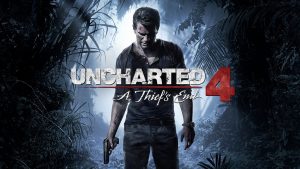
Uncharted is another title where it’s a bit difficult to separate my history with the franchise from my view on this particular installment. That said, it’s up at #2 for a reason. No, Uncharted 4 didn’t just delivered the normal Uncharted action I had expected; had it done so, it might not have even made the list.
Uncharted 4 delivered moments of narrative quiet and relationship drama that felt both wholly deserved (after having spent so many hours with our hero Nathan Drake) and starkly sad. There are two major moments that hit home for me.
The first is early in the game when Nathan is at home with Elena. You spend as much time as you want bumping around the attic storeroom of memories, playing with a toy gun, steeped in the history of this man’s life (and your exploits as a player in the first three games). Then you go downstairs and you eat dinner with the person you’ve decided to commit to. And it’s nice. It’s so unbelievably nice. Except that it’s also shatteringly sad, because as a player, you understand that this is an Uncharted game and that means Nathan is going to go off on uncharted adventures and be forced somehow to leave this comfortable home and life that he’s built for himself and deserves. You can’t play Uncharted 4 by continuing to make plates of pasta night after night, and it is a moment where the known conventions of the game and the narrative arc of the protagonist and my understanding of happiness all collided. Those moments – that’s what video games are for, right?
Later, Elena finds out Nathan’s been lying to her and yells at him and storm off, and Nate decides not to follow her. It is another moment when the game takes a character choice and plucks it out of your hands. I wanted to go home at that point. I wanted to give up all this uncharting. But I couldn’t and it genuinely hurt my heart.
The rest of the game is OK. There’s jumping and shooting and driving a jeep around in the mud and a really cute epilogue.
1. Oxenfree
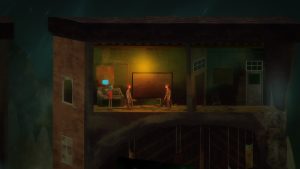
What makes Oxenfree my game of the year? That’s a question I’ve rolled around in my head as I wrote up the other 9 games. If the lower half of my list rewarded mechanics at the detriment of (or in the absence of) narrative, the top few are all games that deliver completely solid mechanics with compelling narrative moments as well.
Oxenfree manages to capture it all. It has a cast of both archetypal yet realistic teen characters, a really fresh-feeling dialogue choice system, and a spooky storyline that blends horror movie tropes with interactive tricks to really deliver moments of surprise, horror, and humor. It’s a bit X-Files, a bit Breakfast Club, a bit Maniac Mansion, a bit Mass Effect.
There is a real sense of dread as a senior year after-hours excursion to a local island starts to turn supernatural, but the game is always grounded in the snappy, youthful dialog that gets exchanged between the characters in an ongoing, overlapping way that isn’t captured as well in other games. There are moments of horror and moments of levity, with all of them fitting in a story that manages to hold all of the necessary emotions without being overburdened.
For a game that depends on choosing between different dialog options, the conversation still feels natural – like you’ve somehow happened upon a conversation and yet are simultaneously responsible for its outcome. The choices that you make matter – not in the grand scheme of things (I mean, we’re past that old canard now on strong narrative games, right?) but in the moments that are potentially more important. The way that your protagonist Alex treat other characters is reflected back at you. It is a game where what you say matters, where word choice affects your relationships – another subtle reflection of life that is often lost in other games with lots of dialog.
That’s the heart of it, really. The shell is also well-made: the storyline holds together enough that I felt compelled to see it through to its natural conclusion. The small puzzle elements feel naturally embedded in the narrative, avoiding the dull kind of Walking Dead radio batteries fetch game. It’s a good game, Brent.
Bonus Content for Premium Members
If you are not a Premium Member, please stop reading now.
If you have not yet received your Premium Membership wristband, simply hold up the QR code that you should have gotten in your email to the screen and shout, “I belong!” and if you mean it, you can stay.
OK, with that out of the way, here are your extra premium 2016 tidbits.
- I finished playing Life is Strange and if I was including older titles, it’d probably be on the list. I really liked it. It shared a lot of the same narrative strengths that Oxenfree exhibited, though I felt that it was sometimes a bit more sappy or a bit too devoted to its end-of-episode twist endings for its own good.
- Yes, I did play Overwatch. It’s a really well made online shooter with classes, but that’s not enough for me. Also, I find their collection/monetization design baffling.
- If you like games that are explicitly trying to say something about video games (and I know the audience there is much smaller), I’d give Pony Island a go. There’s some really interesting fourth-wall-breaking meta that engages with and questions some gaming assumptions and tropes.
- I wish I had played more Pandemic Legacy in 2016.
- I played so much Star Wars: Galaxy of Heroes on my phone in 2016, but I still can’t bring myself to recommend it. I can see all the good design decisions they made, but I also ended up feeling like it was playing me more than I was playing it. It’s not to say I didn’t enjoy my time with it, but it’s not to say that I did either. I don’t know. Mobile game design still sometimes gives me cognitive dissonance as a developer and player.
- I’m not sure Titanfall 2 is worth playing just for That Level, but That Level is pretty damn good.
- If you’re looking for three more 2016 games that I enjoyed, but just not enough to make the list, try The Curious Expedition, Darkest Dungeon, or Devil Daggers.
- If you’re looking for three more 2016 games that I haven’t played or finished, but I have good feelings about, try Inside, ABZU, or Firewatch.
- I own a PSVR unit, and I’m not sure what to think of it yet. It really is a completely different experience, but I haven’t played around with enough games to know if it’ll be more than a blip on the gaming radar.
- If you play games and you want to play games with me, reach out and let me know. Maybe we can set aside some time to do it together. I really do like playing games with other people I know, and I feel like I don’t do it often enough. Maybe we can do some more of that in 2017.